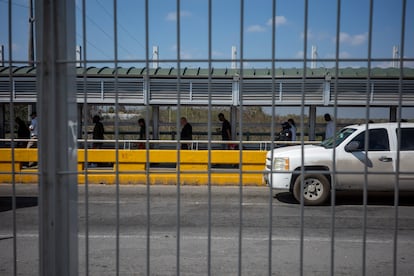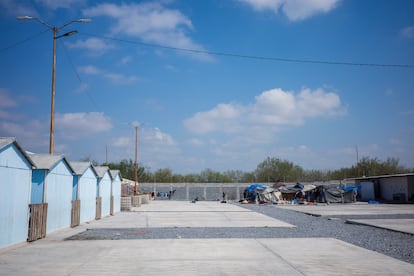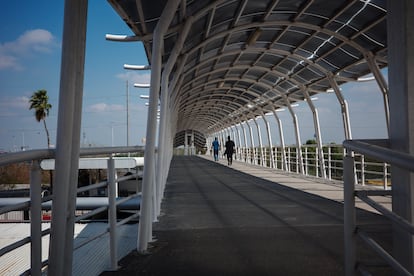One month later, Trump’s threats remain unfulfilled as Mexican shelters sit empty along border
The scenes in Ciudad Juárez, Mexico and in other border cities — from Tijuana to Reynosa —underscore the setbacks thus far of the president’s promise to launch the largest deportation operation in U.S. history

This story was co-published with Puente News Collaborative, a bilingual nonprofit newsroom, convener and funder dedicated to high-quality, fact-based news and information from the U.S.-Mexico border.
Mega shelters for deportees set up by the Mexican government along the border sit mostly empty, one month after President Donald Trump threatened “mass deportations” on day 1 of his administration. The scenes in Ciudad Juárez, Mexico, and in other border cities — from Tijuana in the west to Reynosa in the east —underscore the setbacks, thus far, of Trump’s promise to launch the largest deportation operation in U.S. history. Trump campaigned on a promise to detain and expel an estimated 11 million undocumented persons.

Mexican officials along the border, including in Ciudad Juárez, appear relieved they haven’t seen a swell of deportees yet. “We hope there won’t be a large repatriation,” said Secretary of Welfare Ariadna Montiel Reyes, following a tour of a sprawling, empty tent camp that can potentially hold 2,500 deportees. The federal agency is in charge of providing services for Mexicans returned to their home country in a process often called repatriation.
So far, about 2,000 Mexican migrants have set foot in government-operated shelters, recently said Mexican President Claudia Sheinbaum at her daily press conference. Overall, more than 13,455 migrants have been deported to Mexico, according to Sheinbaum. Among them are also 2,970 migrants from countries other than Mexico, including Cuba and Venezuela, Mexican officials say.
The numbers of deportees sent to Mexico in the last month were higher than the last four weeks under the previous administration of President Joe Biden, said Ariel G. Ruiz Soto, a senior policy analyst at the nonpartisan Migration Policy Institute.
The pace of deportations has since stabilized, if not actually fallen, from the first 10 days of the Trump administration, said Ruiz Soto, who has examined data from both the U.S. and Mexico. “That has a lot to do with the real challenges that ICE [the U.S. Immigration and Custom Enforcement] is facing with limited capacity in the interior,” he said, referring to detention space.
ICE has long told Congress it doesn’t have enough funding to detain all the undocumented immigrants that Trump has promised to arrest. Border Czar Tom Homan told CNN Sunday, “I’m not happy with the numbers, because we got a lot of criminals to find. So what we’re talking about right now is increasing the number of teams, [increasing] the targeting… We got to do more.” ICE and the Department of Defense didn’t respond to inquiries.
Nogales
In Nogales, Mexico, across from the Arizona city of the same name, shelters remain empty or with few migrants, said Alma Cota de Yañez, the executive director of Fundación Empresarial Sonorense, or FESAC, a nonprofit organization focused on immigrant assistance and border development. “We’re not seeing any chaos in our community,” said Cota de Yañez at a meeting of philanthropic organizations in Mexico City.
Just the same, worries remain with U.S.-Mexico history as a guide. Between 1929 and 1939, about one million Mexicans and their U.S.-born children were deported in the so-called “great repatriation,” according to historians in the book Decade of Betrayal. In 1954, the U.S. government deported an estimated hundreds of thousands and their U.S.-born children, in what was known by the racist name of Operation Wetback. Both operations generated widespread fear and anxiety across U.S. cities, especially those with large Latino populations.
Decades later, the wounds of humiliation remain open, raw, on both sides of the border. For that reason, Mexico is taking no chances — in emotion and practical execution. “Mexico te abraza,” or “Mexico Hugs You,” is the government’s campaign slogan.
At the Juárez shelter, blue and gray mattresses lie inside the camp where flashes of cheerful colors come from the orange, pink, and turquoise portable bathrooms outside. Peering over the scene is a larger-than-life statue of Pope Francis, an immigrant defender, with an outstretched hand releasing a dove. Nearly a decade ago, the statue of the head of the Catholic Church was placed at El Punto, near the historic Chamizal park, on land that ended a U.S.-Mexico boundary dispute.
Tijuana
In downtown Tijuana, another temporary shelter has sprouted with bunk beds, showers, and a kitchen for migrant stays of just one or two days. The shelter carries the name Juventud 2000.
The shelter’s residents share a commonality, whether they’re in the state of Baja California, Chihuahua or Tamaulipas: they have been left with no options to gain asylum in the U.S. or gain lawful U.S. entry with the now-defunct CBP One mobile phone app.
Some Mexican migrants said they would remain in Tijuana, banking on a reversal in Trump’s policies. That’s deepening concerns about overwhelming border communities in the coming weeks and months. The Sheinbaum government is handing out $97 debit cards to encourage migrants to return to their hometowns in the interior of the country.
Matías Ezequiel, 35, says that his hope “ended when Trump took office.” “But we are from Puebla, and there is a lot of violence there,” he added. “My children were threatened — we are definitely not going back.”
Some migrants will opt to jump the wall in Tijuana, or take a speed boat through the water, they said. Others will take the mountain routes through the nearby city of Tecate to the east, or they will try to use other people’s visas to cross through vehicular checkpoints at the border.
In Tijuana, the prices coyotes charge to smuggle migrants into the U.S. have doubled, according to some of them. The cost of these crossings ranges from $6,000 to $10,000, double what they used to cost. But coyotes are also scrambling for business in other cities, including Juárez, where prices have dropped due to falling demand, according to humanitarian workers at migrant nonprofits.
Reynosa
Similarly, in Reynosa, migrants have retreated to shelters or are sleeping in the streets. Around 100 migrants live in a state of limbo in Senda de Vida 2, one of the city’s largest private shelters with enough room for about 2,000 people.

At Casa del Migrante Nuestra Señora de Guadalupe, a smaller private shelter, Mexican nationals, deported after ICE raids during the last couple of weeks, have sought refuge. There are about 160 or so migrants living in this compound, most of them Mexicans who are worried about security in their home states.
“The people that are there, what else are they going to do?” said Kevin McNamara, the executive director of 13:2 Initiative, a Texas-based organization that distributes donations to shelters. “Maybe they’re holding onto some hope that something might work out, but it’s probably going to be four years before there’s any significant pathways,” he added.
Del Rio
Ironically, the only large-scale arrival of newcomers on the border appear to be the hundreds of military troops on both sides. Sheinbaum sent an additional 10,000 national guard troops to Mexican border states in the past month. Some have joined other members of the Mexican military in searching for clandestine tunnels used for smuggling and U.S.-bound vehicles carrying fentanyl, a desperate search fueled by Trump’s threats of imposing 25% tariffs on Mexican imports, which would deeply hurt U.S. consumers.
On the U.S. side, the Trump administration has deployed 1,500 additional troops, adding to the 2,500 that were already on the southern U.S. border, to provide support for the U.S. Border Patrol.
In Del Rio, Texas, the presence of U.S. military members in hotels already crammed with state troopers have left some locals perplexed, in communities considered among the safest in the United States.
“Just as a community member, I’m not seeing them in their military uniforms,” said Tiffany Burrow, who runs the nonprofit Val Verde Humanitarian Border Coalition. “I’m seeing them off duty, walking up and down our Main Street, going to Chick-fil-A or Whataburger.” She said the flow of migrants seeking help dropped from about 89 per day in early January to zero.
El Paso
Somewhere between the powerful economic and cultural forces that bind two countries and two border cities lies the confusion. At the shelters and elsewhere, speculation on social media agitate the public further. In El Paso, a county of more than 950,000 residents, more than 80% of the population is Latino. Here, it seems, everyone is suspected of being undocumented.
A recent video shared on Instagram shows agents wearing vests with the logos of the U.S. Border Patrol asking a group of English-speaking young men at a horse training facility about their citizenship. One of the armed agents even demands they provide proof. “I’m a U.S. citizen, just to clarify, born in El Paso, Texas,” the young man answers. The U.S. Border Patrol would not comment on the video, citing an investigation. But agent Orlando Marrero-Rubio said they “are not randomly asking people for immigration papers.” Anti-smuggling and intelligence units carry out targeted enforcement involving a specific suspect and have a warrant, he added.

However, the video and those present when the agents interrogate the young men suggest otherwise. They say the agents never produced a warrant to enter the private property. At the horse stables, a worker named Ventura, who declined to provide his surname, summed up in Spanish how he felt about the threat of deportations. ”We are very sad,” he said. “We feel corralled. Not by the horses but by immigration agents.”
Sign up for our weekly newsletter to get more English-language news coverage from EL PAÍS USA Edition
Tu suscripción se está usando en otro dispositivo
¿Quieres añadir otro usuario a tu suscripción?
Si continúas leyendo en este dispositivo, no se podrá leer en el otro.
FlechaTu suscripción se está usando en otro dispositivo y solo puedes acceder a EL PAÍS desde un dispositivo a la vez.
Si quieres compartir tu cuenta, cambia tu suscripción a la modalidad Premium, así podrás añadir otro usuario. Cada uno accederá con su propia cuenta de email, lo que os permitirá personalizar vuestra experiencia en EL PAÍS.
¿Tienes una suscripción de empresa? Accede aquí para contratar más cuentas.
En el caso de no saber quién está usando tu cuenta, te recomendamos cambiar tu contraseña aquí.
Si decides continuar compartiendo tu cuenta, este mensaje se mostrará en tu dispositivo y en el de la otra persona que está usando tu cuenta de forma indefinida, afectando a tu experiencia de lectura. Puedes consultar aquí los términos y condiciones de la suscripción digital.
More information
Archived In
Últimas noticias
Chris Martin, Taylor Swift, Elijah Wood and other famous wedding ‘crashers’
‘How does it feel to be a failure?’: Elizabeth Berkley’s journey from ‘Showgirls’ ridicule to vindication
The story of the Málaga virus: The code that haunted Google’s cybersecurity center director for 30 years
The impact of Ecuador’s mega-prison: A polluted river, cleared forests and military checkpoints
Most viewed
- Christian Louboutin: ‘Young people don’t want to be like their parents. And if their parents wear sneakers, they’re going to look for something else’
- The low-cost creative revolution: How technology is making art accessible to everyone
- Liset Menéndez de la Prida, neuroscientist: ‘It’s not normal to constantly seek pleasure; it’s important to be bored, to be calm’
- All the effects of gentrification in one corner of Mexico’s Colonia Roma
- December Social Security and SSI payments: Dates, double checks and the 2026 COLA increase










































